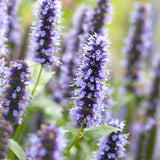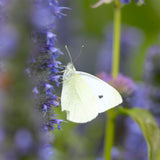PRESALE
Spring 2025 Shipping Schedule: 2/28/2025
Agastache is a perennial with beautiful flower spires of pink, mauve, blue, orange and white that bloom summer to early fall. Agastache is in the Hyssop herb family and is used in teas. Agastache tolerates low moisture and poor soil conditions and grows best in drought conditions.
About this Variety
Blue Fortune produces blue-lavender flower spikes that bloom from summer into fall. Leaves are often used in potpourri and to flavor food and drink.
Highlights
- Beneficial to pollinators; attracts birds & butterflies
- Easy to grow
- Deer & critter resistant
- Drought tolerant
- Long bloom time
Exposure:
Full sun
Blooms:
Summer to Early Fall
Height:
Grows 24-36" tall
Spacing/Depth:
Plant 12-24" apart, 1-2" deep
USDA Zones:
Grow as Perennial in zones 5-9. Grow as Annual elsewhere.
Growing Instructions
Plant Agastache in the spring after all danger of frost has passed. Agastache prefers full sun locations. The ideal soil is rich and porous and drains well, yet still holds enough water for the roots. If your soil is heavy clay and drains slowly, or very sandy and does not hold water, add organic soil amendments like peat moss or ground bark. Spread a 3-4 inch layer of soil amendment if needed and incorporate into the soil to a depth of 10 inches. Plant rhizomes 1-2" deep and 12-24" apart. Cover with soil. When planting a large number of Agastache in one bed, excavate the entire area to the recommended depth, work fertilizer into the bottom of the trench, set out rhizomes and then cover all at once. Water thoroughly at planting. While actively growing, water frequently and thoroughly so that water will reach roots. Mulch to keep the soil cool and to prevent the soil from drying out. Apply fertilizer during growing season until foliage starts to turn yellow. After frost has damaged the foliage in non-hardy zones, dig up rhizomes, dry for a few days, trim off foliage and store in barely damp peat moss at 50-60ºF during the winter. Be sure to check on them a few times to make sure they are not too moist or too dry. Replant in spring after all danger of frost has passed.
Care Tip
Deadhead after blooming to encourage more flowers to return in the same season. Where winter weather may be severe, plants should be located in a protected spot in the garden with southern exposure. Do not remove leaves and stems before winter as they provide some protection when left in place until spring. Agastache is a self-sowing plant and its seedlings may bloom and grow in different colors from the parent plant.
















